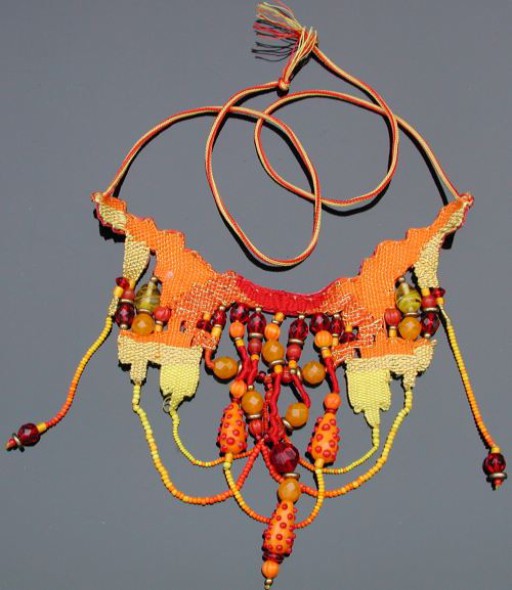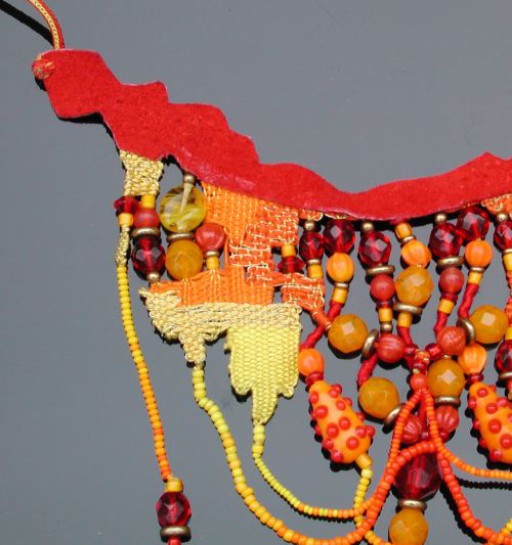Tapestry needleweaving was developed by Helen Baines as a portable substitute for the traditional (and much larger pieces) she originally made. She has taught this method for combining Beads and Threads for many years. I first read about it in Threads magazine, but didn't actually try it until I took a class.
I thought taking a class would be easier, and that I could just get the teacher to tell me all the neat little tricks, instead of having to discover them for myself. Wrong. Though the teacher was an experienced textile artist, her knowledge of the technique dated to the same article I'd read, and after blindly following her well meant but somewhat uninformed advice, I proceeded to make some unjudicious design decisions (this is called “making mistakes” by beginning artists; and “pushing the envelope” by more confident ones). Determined to make this piece work, I learned a great deal about tapestry needleweaving's limitations. The weaving must be tight enough to support the weight of having beads strung on the warps. I didn't weave tightly enough, and the piece desparately needed extra support. I provided this by gluing some red suede to the back.
I hoped to accomplish two objectives with the piece: use some fun, idiosyncratically colored (for a stone bead person, which I was, at the time) beads and see if I couldn't find a faster method than embroidery to mix beads and threads. I succeeded at the first, failed dismally at the second: I've made the 4 tapestry needlewoven pieces shown here, plus two more in private collections, and then gave the technique up forever.
The first was to use those wonderful orange and red dotties. At the time I strung mostly with stone beads, and simply didn't have enough beads to make a necklace incorporating the dotties entirely of beads. The only other necklace using those beads is mostly made of peyote stitched seed beads, and took even longer to do. There just doesn't seem (for me, anyway) a fast method to string with those dotties! (This page is showing its age, a little. Now, of course, I could just make orange and red beads to match...I still love the color combination, but having taken up glass beadmaking, I can't stand to use the inexpensive Indian glass beads in my regular work any more.)

This picture is better than the old one, but the coolpix still clips the reds.
I did, on the other hand, have a lot of floss and yarns leftover from my embroidery days. I hoped the tapestry technique would allow me to mix threads and beads with a somewhat quicker working method than beaded embroidery. Though tapestry needleweaving is a little faster than embroidery, it isn't enough to make up for the reduced flexibility freestyle embroidery gives. It is however very portable, and ideal for trips, provided you've figured out which beads you want to use ahead of time.
This is also the first piece in which kumihimo played a major portion in the design. At that time I had only Catherine Martin's book, and no equipment. I rigged something from a soldering platform, using sets of four reproduction coins (because they had holes in them to tie the strings to) to weight the eight strands down. Because I had no way to adjust the length of the threads, they were always too long, and consequently twisted and snarled around each other. Even with primitive equipment and terribly inefficient working technique, I was entranced.

The back shows the leather support, and also some of looping that I think gives the piece some of its interest.
This necklace is braided with Maru-genji gumi, a good 16 strand braid for the beginner, as the pattern is very easy to track. Unfortunately, I didn't record the exact pattern I used, but it probably a variation of ‘c’ in Catherine Martin's book.
Unless otherwise noted, text, image and objects depicted therein copyright 1996--present sylvus tarn.
Sylvus Tarn